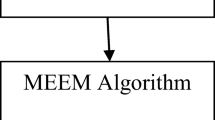Abstract
The Retinal Blood Vessel segmentation plays a vital role in automatic retinal disease screening systems. It helps in the screen process of glaucoma, diabetic retinopathy, and other eye- related diseases. The primary objective of this paper is to consequently segment the vessels in fundus retinal pictures, which encourages us in diabetic retinopathy screening. The initial enhancement of image is carried out using Histogram Equalization. After which, the green channel of the image is applied with morphological image processing to remove the optic disc. The image segmentation is then performed to modify the intensity of contrast and little pixels viewed as noise are evacuated. The obtained image would represent the blood vessels of the original image. This paper proposes an expected maximization algorithm to segment the blood vessels in the human retina. The novelty of these method is to perform uniform intensity distribution in retinal images. The proposed method was tested by publicly available datasets such as DRIVE, STARE, MESSIDOR, DIARETDB0, and University of Lincoln. The proposed method has obtained an average area under receiver operating characteristics of 0.9203. Moreover, this shows a better performance than other state-of-the-art methods.
Access this chapter
Tax calculation will be finalised at checkout
Purchases are for personal use only
Similar content being viewed by others
References
Jiang, Z., Zhang, H., Wang, Y., Ko, S.B.: Retinal blood vessel segmentation using fully convolutional network with transfer learning. Comput. Med. Imaging Graph. 68(1), 1–5 (2018)
Moccia, S., De Momi, E., El Hadji, S., Mattos, L.S.: Blood vessel segmentation algorithms review of methods, datasets and evaluation metrics. Comput. Methods Programs Biomed. 158(1), 71–91 (2018)
Yue, K., Zou, B., Chen, Z., Liu, Q.: Improved multi-scale line detection method for retinal blood vessel segmentation. IET Image Process. 12(8), 1450–1457 (2018)
Zhao, J., Yang, J., Ai, D., Song, H., Jiang, Y., Huang, Y., Zhang, L., Wang, Y.: Automatic retinal vessel segmentation using multi-scale superpixel chain tracking. Digit. Signal Process. 81(1), 26–42 (2018)
Chaudhuri, S., Chatterjee, S., Katz, N., Nelson, M., Goldbaum, M.: Detection of blood vessels in retinal images using two-dimensional matched filters. IEEE Trans. Med. imaging 8(3), 263–269 (1989)
Frangi, A.F., Niessen, W.J., Vincken, K.L., Viergever, M.A.: Multiscale vessel enhancement filtering. In: International Conference on Medical Image Computing and Computer-Assisted Intervention, pp. 130–137. Springer, Berlin, Heidelberg (1998)
Soares, J.V., Leandro, J.J., Cesar, R.M., Jelinek, H.F., Cree, M.J.: Retinal vessel seg- mentation using the 2-D Gabor wavelet and supervised classification. Trans. Med. Imaging 25(9), 1214–1222 (2006)
Krissian, K., Malandain, G., Ayache, N.: Directional anisotropic diffusion applied to segmentation of vessels in 3D images. In: International Conference on Scale-Space Theories in Computer Vision, pp. 345–348. Springer (1997)
Hassouna, M.S., Farag, A.A., Hushek, S., Moriarty, T.: Cerebrovascular segmentation from TOF using stochastic models. Med. Image Anal. 10(1), 2–18 (2006)
Nekovei, R., Sun, Y.: Back-propagation network and its configuration for blood vessel detection in angiograms. IEEE Trans. Neural Netw. 6(1), 64–72 (1995)
Xu, C., Pham, D.L., Prince, J.L.: Image segmentation using deformable models. In: Handbook of Medical Imaging. pp. 129–174 (2000)
Chan, T., Vese, L.: An active contour model without edges. In: International Conference on Scale-Space Theories in Computer Vision, pp. 141–151. Springer, Berlin, Heidelberg (1999)
Carrillo, J.F., Hoyos, M.H., Dvila, E.E., Orkisz, M.: Recursive tracking of vascular tree axes in 3D medical images. Int. J. Comput. Assist. Radiol. Surg. 1(6), 331–339 (2007)
Friman, O., Hindennach, M., Khnel, C., Peitgen, H.O.: Multiple hypothesis template tracking of small 3D vessel structures. Med. Image Anal. 14(2), 160–171 (2010)
Cohen, L.D., Kimmel, R.: Global minimum for active contour models: A minimal path approach. Int. J. Comput. Vis. 24(1), 57–78 (1997)
Deschamps, T., Cohen, L.D.: Fast extraction of minimal paths in 3D images and applications to virtual endoscopy. Med. Image Anal. 5(4), 281–299 (2001)
Trevor, H., Tibshirani, R., Friedman, J.: Unsupervised learning. In: The Elements of Statistical Learning, pp. 485–585. Springer, New York, NY (2009)
Leemput, V., Maes, F.: Automated model-based tissue classification of MR images of the brain. IEEE Trans. Med. Imaging 18(10), 897–908 (1999)
Ganin, Y., Lempitsky, V.S.: N4-fields: neural network nearest neighbor fields for image transforms, In: Asian Conference on Computer Vision, pp. 536–551. Springer, Cham (2014)
Maninis, K.K., Pont-Tuset, J., Arbelez, P., Van Gool, L.: Deep retinal image understanding. In: Ourselin, S., Joskowicz, L., Sabuncu, M., Unal, G., Wells, W. (eds) Medical Image Computing and Computer-Assisted Intervention, Lecture Notes in Computer Science, vol. 9901, pp. 140–148. Springer, Cham (2016)
Wang, S., Yin, Y., Cao, G., Wei, B., Zheng, Y., Yang, G.: Hierarchical retinal blood vessel segmentation based on feature and ensemble learning. Neurocomputing 149(1), 708–717 (2015)
Author information
Authors and Affiliations
Corresponding author
Editor information
Editors and Affiliations
Rights and permissions
Copyright information
© 2020 Springer Nature Singapore Pte Ltd.
About this paper
Cite this paper
Murugan, R. (2020). The Retinal Blood Vessel Segmentation Using Expected Maximization Algorithm. In: Gupta, M., Konar, D., Bhattacharyya, S., Biswas, S. (eds) Computer Vision and Machine Intelligence in Medical Image Analysis. Advances in Intelligent Systems and Computing, vol 992. Springer, Singapore. https://doi.org/10.1007/978-981-13-8798-2_6
Download citation
DOI: https://doi.org/10.1007/978-981-13-8798-2_6
Published:
Publisher Name: Springer, Singapore
Print ISBN: 978-981-13-8797-5
Online ISBN: 978-981-13-8798-2
eBook Packages: Intelligent Technologies and RoboticsIntelligent Technologies and Robotics (R0)




